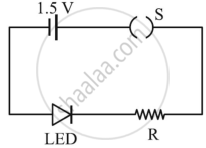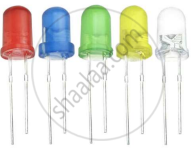Advertisements
Advertisements
प्रश्न
Draw the circuit diagram of an illuminated photodiode in reverse bias. How is photodiode used to measure light intensity?
उत्तर
The circuit diagram of an illuminated photodiode in reverse bias can be represented as

The greater the intensity of light, the greater is the number of photons falling per second per unit area. Thus, the greater the intensity of light, the greater is the number of electron−hole pairs produced at the junction. The photocurrent is, thus, directly proportional to the intensity of light. This can be used for measuring the intensity of incident light.
APPEARS IN
संबंधित प्रश्न
How is a Zener diode fabricated?
Describe, with the help of a circuit diagram, the working of a photodiode.
Briefly explain its working. Draw its V - I characteristics for two different intensities of illumination ?
What happens to the width of depletion player of a p-n junction when it is (i) forward biased, (ii) reverse biased?
The plate resistance of a triode is 8 kΩ and the transconductance is 2.5 millimho. (a) If the plate voltage is increased by 48 V and the grid voltage is kept constant, what will be the increase in the plate current? (b) With plate voltage kept constant at this increased value, by how much should the grid voltage be decreased in order to bring the plate current back to its initial value?
What is the magnitude of the potential barrier across a Ge p-n junction?
A p-n photodiode is fabricated from a semiconductor with a band gap of 2.5 eV. lt can detect a signal of wavelength ______.
Which one of the following is not the advantage of LED?
Read the following paragraph and answer the questions.
|
LED is a heavily doped P-N junction which under forward bias emits spontaneous radiation. When it is forward-biased, due to recombination of holes and electrons at the junction, energy is released in the form of photons. In the case of Si and Ge diode, the energy released in recombination lies in the infrared region. LEDs that can emit red, yellow, orange, green and blue light are commercially available. The semiconductor used for fabrication of visible LEDs must at least have a band gap of 1.8 eV. The compound semiconductor Gallium Arsenide – Phosphide is used for making LEDs of different colours.
|
- Why are LEDs made of compound semiconductor and not of elemental semiconductors?
- What should be the order of bandgap of an LED, if it is required to emit light in the visible range?
- A student connects the blue coloured LED as shown in the figure. The LED did not glow when switch S is closed. Explain why?

OR
iii. Draw V-I characteristic of a p-n junction diode in
(i) forward bias and (ii) reverse bias
Why a photo-diode is operated in reverse bias whereas the current in the forward bias is much larger than that in the reverse bias? Explain. Mention its two uses.

